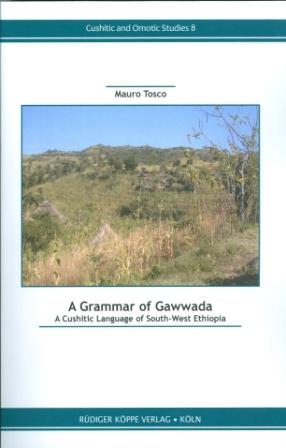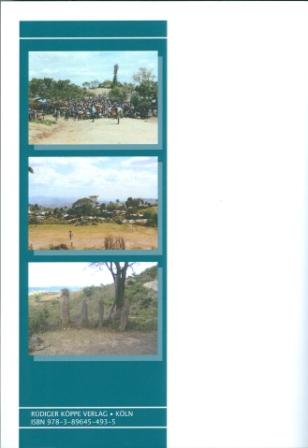

A Grammar of Gawwada
A Cushitic Language of South-West Ethiopia
Author: Mauro Tosco. Series edited by: Hans-Jürgen Sasse †, Mauro Tosco.
Series: COS Cushitic and Omotic Studies Volume 8
2021396 pp.
2 colour maps, 2 colour tree models, 1 colour graph, 5 b/w graphs, 1 vowel chart, 31 sonagrams, 3 colour figures, numerous tables and charts, selected Gawwada texts: proverbs, riddles and folktales
Text language(s): English
Format: 170 x 240 mm
830 g
Paperback
€ 98.00
Buy 'A Grammar of Gawwada' as a downloadable PDF document directly from our online shop »
Order 'A Grammar of Gawwada' as print edition »
Gawwada is a member of the so-called Dullay dialect cluster and is spoken in South-West Ethiopia (administratively, a part of the “Southern Peoples, Nations, and Nationalities Regional State” SPNNR).
Within Dullay a Western and an Eastern group of dialects can be opposed; the former is basically made up of Ts’amakko (ISO 639-3 tsb) and Gawwada, and, geographically, spans the two banks of the Weyt’o river; the Eastern dialects occupy the highlands to the east and north of Gawwada; Harso, Dobaze, and the other dialects (grouped under Gawwada in ISO 639-3) are representative of the Eastern group.
Dullay has gained wider acceptance in the linguistic literature and will be retained here, although it must be stressed that none of these denominations bears any meaning to the speakers themselves.
In this book, Gawwada is used for the dialect spoken in the town of Gawwada and in the neighboring villages. The village lies at an approximate elevation of 1,650 meters; its approximate location is 5°25’ N, 37°14’ E, around 40 km westwards of Konso, and a dozen kilometers north of the main road leading from Konso to Jinka and the Omo valley.
In Ethiopia, Gawwada was until recently used as a cover term for all the Dullay-speaking groups except the Ts’amakko, who live on the western bank of the Weyt’o river. Although linguistically unwarranted, the division of the Dullay-speakers between Gawwada and Ts’amakko division reflects well the cultural and economic cleavage between the inhabitants of the highlands, with their economy centered around agriculture, and the Ts’amakko, pastoralists and political allies of the Omotic Hamar and Banna, from whom they have been heavily influenced culturally.
The Dullay dialects are not endangered. Bi- and multilingualism involves first of all Amharic, then Konso and other Konsoid varieties. The Dullay dialects are not usually written.
A dictionary of Gawwada has been published by us, as well as grammar of another language of the Dullay cluster, see the links below. You will find the full review text by Yvonne Treis under PDF documents:
Accompanying material:
Reviews
Mauro Tosco, one of the most prolific authors in the field of Cushitic linguistics, has recently published a grammar of a little-known variety of the Dullay-cluster (East Cushitic) in southwestern Ethiopia. His grammar of Gawwada [ISO 639‑3: gwd/glottocode: gaww1239] adds to an impressively long list of publications on many Cushitic languages, which includes several grammatical descriptions, namely of the Karre and Tunni varieties of Somali (Tosco 1989 and 1997), the critically endangered language Dahalo (Tosco 1991) and Dhaasanac (Tosco 2001). Following the grammatical sketch by Amborn et al. (1980), focusing on Gollango and Harso-Dobase, and Savà’s grammar of Ts’amakko (2005), Tosco’s Gawwada grammar is the third and most detailed description of a Dullay variety. It is published, both on paper and electronically (in pdf), as the eighth volume of the series Cushitic and Omotic Studies, which is edited by Tosco himself. The present review is based on the paper version. [...]
The author is to be lauded for the database of natural speech on which this work is based, for highlighting typological and genetic rarities in the grammar of Gawwada and for providing a comprehensive account covering all grammatical domains from phonology to information structure, which does not find many parallels in Cushitic grammaticography.
Yvonne Treis in LLA Linguistique & Langues Africaines, 9(1)/2023, 1-6
PDF documents:
 | Review by Yvonne Treis in LLA Linguistique & Langues Africaines 9(1)/2023 | (≈ 462 kB) |
| « back | Print version | [top] |
 Books
Books Audio
Audio Biographies
Biographies Series
Series Festschrifts
Festschrifts Journals
Journals